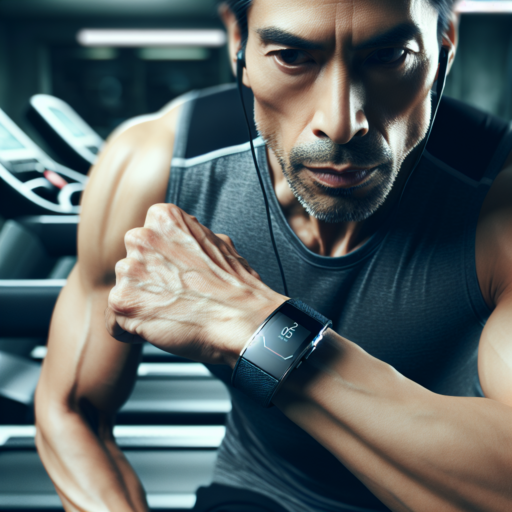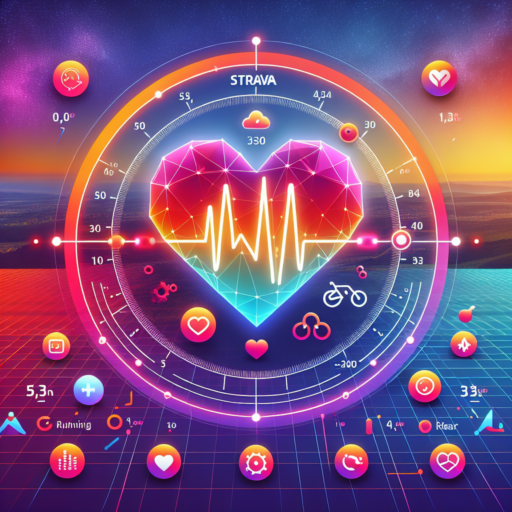What is a Heart Rate Monitor and Why Do You Need One?
A heart rate monitor is a device that measures and displays your heart rate in real-time. It’s a vital tool not just for athletes but for anyone interested in keeping a close eye on their physical health. Heart rate monitors come in various forms, including chest straps, wristwatches, and even devices that can be worn on the ear or integrated into fitness equipment.
One of the key reasons to use a heart rate monitor is for efficient workout sessions. By monitoring your heart rate, you can ensure that you are not overexerting yourself or, conversely, not putting in enough effort. It allows you to maintain your workout within the optimal heart rate zones for fat burning, endurance training, or cardiovascular improvement. Furthermore, understanding your heart rate patterns can help in the early detection of potential health issues.
Moreover, a heart rate monitor is an indispensable tool for those looking to track their fitness progress. It provides tangible data that can show improvements over time, such as a lower heart rate at rest or a quicker recovery after intense physical activity. This kind of data can serve as motivation and can help personalize your training to fit your unique health profile and goals.
Types of Heart Rate Monitors: Chest Straps vs. Wrist Watches vs. Smart Bands
When it comes to tracking your heart rate, the technology you choose can greatly affect your data’s accuracy and usability. The main types of heart rate monitors on the market are chest straps, wrist watches, and smart bands. Each offers distinct benefits and drawbacks depending on your fitness level, preferred activities, and what features matter most to you.
Chest straps are known for their precision. They closely monitor your heart rate by detecting electrical signals directly from your heart. This makes them highly accurate, a top choice for athletes and fitness enthusiasts who need reliable data to optimize their training. However, some find them uncomfortable during long workouts or dislike the idea of wearing an extra piece of equipment.
Wrist watches, on the other hand, blend fitness tracking with daily wearability. Although they may not match the chest strap’s accuracy, they offer a good balance of convenience and functionality. Ideal for those who want to monitor their heart rate alongside other fitness metrics without wearing a dedicated device. Recent advancements have improved their precision, but placement on the wrist can still sometimes result in discrepancies.
Lastly, smart bands have emerged as a popular middle-ground. These devices are designed for 24/7 wearability and typically come with a host of features beyond heart rate monitoring, such as step counting and sleep tracking. While they might not be as accurate as chest straps, smart bands offer a comprehensive view of your health and are especially appealing for those looking to stay generally active and informed about their fitness levels.
Top Features to Look for in a Heart Rate Monitor
When considering a heart rate monitor to enhance your fitness journey or manage health conditions, knowing the key features to look for can make a significant difference in your selection process. These devices have evolved from simple pulse trackers to sophisticated health gadgets providing a plethora of data to users. Here, we highlight the top features that should be on your checklist when scouting for the ideal heart rate monitor.
Accuracy and Reliability
At the heart of a good heart rate monitor is its accuracy and reliability. This feature is paramount as it forms the basis of all the data you will receive. Devices that employ both optical (wrist-based) and chest strap sensors tend to offer the best accuracy. Optical sensors are convenient for continuous monitoring, while chest straps are ideal for capturing more precise heart rate data during intense physical activities.
Connectivity and Compatibility
In today’s interconnected world, the ability of your heart rate monitor to seamlessly sync with other devices is crucial. Look for models that offer Bluetooth or ANT+ connectivity, allowing you to easily connect to your smartphone, fitness apps, or sports watches. This feature not only ensures you can track your progress over time but also enables you to integrate the heart rate data with other health metrics for a comprehensive health overview.
Additional Health Metrics
While the primary function of a heart rate monitor is to measure your pulse, advanced models now offer a range of additional health metrics such as VO2 max estimations, calorie burn, sleep tracking, and stress monitoring. These insights can be invaluable for tailoring your fitness routine or lifestyle adjustments to achieve better overall health and well-being.
How to Use a Heart Rate Monitor Effectively for Exercise
Using a heart rate monitor effectively for exercise can transform your workout from a basic routine to a highly targeted, efficiency-boosting activity. A heart rate monitor helps you gauge the intensity of your exercise, ensuring you’re working within the right heart rate zones to achieve your fitness goals. Whether you’re looking to improve cardiovascular health, enhance fat burning, or increase endurance, understanding your heart rate is crucial.
Understand Your Heart Rate Zones
Before you begin using a heart rate monitor, it’s essential to understand the different heart rate zones. These zones range from very light intensity, ideal for warm-ups and cool-downs, to maximum effort, which should only be maintained for short bursts during high-intensity interval training. By exercising within specific heart rate zones, you can tailor your workout to fit your fitness goals more accurately. A heart rate monitor takes the guesswork out of this process, giving you real-time feedback on your effort level.
Set Up Your Heart Rate Monitor Correctly
For your heart rate monitor to be an effective workout tool, it must be set up correctly. This includes entering personal information such as age, weight, and maximum heart rate if known. Accurate setup ensures that the feedback you receive is tailored to you, making your training sessions more effective. Most heart rate monitors will use this data to alert you when you’re above or below your target heart rate zone, allowing you to adjust your effort levels on the fly.
Remember, the key to using a heart rate monitor effectively is not only wearing it during your exercises but also paying attention to the data it provides. Adjusting your workout intensity based on your heart rate zones encourages a more efficient exercise session, leading to better fitness outcomes. Over time, tracking your heart rate can also provide insight into your overall health and fitness progression.
The Benefits of Monitoring Your Heart Rate During Workouts
Monitoring your heart rate during workouts presents a multitude of advantages that can significantly enhance your fitness routine. By keeping an eye on this crucial metric, individuals gain insights into their cardiovascular health and workout intensity. This personalized data becomes a guiding star for optimizing workout sessions, ensuring that each regimen is not just about sweating it out but about smartly investing in one’s health and well-being.
Firstly, monitoring your heart rate helps in identifying the fat-burning zone. This zone, typically between 50% and 70% of your maximum heart rate, is where the magic of weight loss and cardiovascular efficiency unfolds. By staying within this range, exercisers can maximize fat loss over time without overexerting themselves. It’s an essential tool for those focused on shedding weight or improving their heart health, making each workout count toward their goals.
Additionally, tracking your heart rate during exercises allows for the customization of your workout plan. Understanding how your heart responds to various exercises enables you to tailor your fitness regime to your body’s needs, promoting better health outcomes. For instance, if your heart rate spikes too quickly, it might suggest the need for a gradual increase in intensity or a focus on endurance training. It empowers you to make informed decisions, helping prevent overtraining and the risk of injury. This level of customization is paramount for long-term fitness success and health.
Heart Rate Monitor Accuracy: What You Need to Know
Understanding the accuracy of heart rate monitors is crucial whether you’re an athlete tracking your fitness progress, a health enthusiast keeping an eye on your daily activities, or someone monitoring health conditions. The precision of these devices varies based on several factors including type, wearability, and technology used. Knowing the ins and outs can help you choose the right monitor for your needs and ensure you’re getting the most reliable data.
Factors Influencing Heart Rate Monitor Accuracy
- Type of Monitor: Chest strap monitors tend to offer the most accurate readings by using electrical signals to track heart rate. Wrist-based monitors, though more convenient, may sacrifice a bit of accuracy due to motion and distance from the heart.
- Fit and Placement: A loosely fitted monitor can give inaccurate readings. It’s important to wear the device as directed, ensuring it’s snug but not too tight.
- Technology Used: Monitors using optical technology (like many wrist-worn devices) measure blood flow to gauge heart rate. Environmental factors and physiological differences can affect their accuracy.
Moreover, understanding the limitations of your heart rate monitor and how to mitigate potential inaccuracies is key. For serious health tracking or athletic training, investing in a high-quality monitor and knowing how to use it correctly can make a significant difference in the reliability of the data you’re basing your health and fitness decisions on.
Best Heart Rate Monitors for 2023: Models and Reviews
Finding the best heart rate monitors for 2023 has become a priority for fitness enthusiasts, athletes, and anyone interested in keeping a close eye on their cardiovascular health. This year, the market is brimming with models that offer an array of features designed to cater to various needs and preferences. From models that integrate seamlessly with smart devices to those designed for precision and durability, understanding the key features and user feedback is essential in making an informed choice.
Top Features to Look for in 2023 Heart Rate Monitors
- Accuracy: Precision in tracking heart rate data is paramount, particularly for athletes and individuals monitoring specific health conditions.
- Connectivity: Compatibility with other devices and apps enhances the utility of the monitor, enabling users to sync data effortlessly for a comprehensive health overview.
- Comfort and Durability: A heart rate monitor should be comfortable to wear for extended periods and durable enough to withstand the rigors of daily use and exercise.
The evolution of heart rate monitors in 2023 brings forth models that are not just more user-friendly but also incorporate advanced technologies like AI to offer predictive insights into heart health. In addition, waterproof designs and extended battery life have become more common, ensuring that these devices can be used in a variety of settings, from swimming pools to long-distance running trails.
Reviews from users this year emphasize the importance of a seamless user experience, highlighting devices that offer easy navigation and quick data access. The preference leans towards lightweight models that do not compromise on battery life or the range of monitoring features. As we delve into specific reviews, it becomes clear that the best heart rate monitors of 2023 are those that align with the user’s lifestyle, fitness goals, and health monitoring needs.
How to Connect Your Heart Rate Monitor With Fitness Apps
Connecting your heart rate monitor with fitness apps can significantly enhance your workout experience by allowing you to track your heart rate in real-time, understand your fitness levels, and tailor your exercise regimen for better health outcomes. To get started, it’s essential to ensure that both your heart rate monitor and your preferred fitness app are compatible. Most modern heart rate monitors are designed to be compatible with a wide range of fitness apps, but checking the compatibility list on the manufacturer’s website is a good first step.
Once compatibility is confirmed, the next step is to pair your heart rate monitor with your smartphone or tablet. This usually involves turning on the heart rate monitor, enabling Bluetooth on your device, and then selecting your heart rate monitor from the list of available Bluetooth devices. Some fitness apps may require you to add the heart rate monitor directly through the app’s settings. Navigating to the settings menu and looking for a section related to heart rate monitors or external devices usually accomplishes this.
After successfully connecting your heart rate monitor with your fitness app, it’s important to wear the monitor correctly to ensure accurate readings. The specifics can vary depending on the type of monitor you have, but generally, chest strap monitors should be worn just below the chest muscle, and wrist-based monitors should be worn snugly above the wrist bone. Initializing a test run within your fitness app can help you confirm that the heart rate monitor is working correctly and communicating effectively with the app.
No se han encontrado productos.
Maintaining Your Heart Rate Monitor for Longevity and Reliability
Maintaining your heart rate monitor is essential to ensure its longevity and reliability. Whether you’re an avid athlete or someone who relies on it for health monitoring, the proper care can make a significant difference. One key aspect is regular cleaning. After each use, gently wipe the sensor and strap with a soft cloth dampened with water or a mild soap solution. This prevents the build-up of sweat and oils that can interfere with the sensor’s ability to accurately read your heart rate.
Storage is another critical factor. Always store your heart rate monitor in a cool, dry place away from direct sunlight and extreme temperatures. Excessive heat or cold can damage the electronic components, while direct sunlight can degrade the sensor and strap over time. Furthermore, ensure that the battery compartment is dry before storing to avoid any potential corrosion that could impact its functionality.
Lastly, regular battery checks and replacements are vital. A weakening battery not only affects the accuracy of readings but can also lead to data loss. Refer to your heart rate monitor’s manual for specific guidance on how often to replace the battery and the recommended type. This proactive approach not only safeguards your device but also ensures you’re always ready for your next workout or health check without any interruptions.
Troubleshooting Common Issues with Heart Rate Monitors
Heart rate monitors have become an essential tool for athletes and fitness enthusiasts aiming to optimize their training sessions. However, encountering issues with these devices can be frustrating and may lead to inaccurate data collection. Understanding common problems and how to fix them is key to ensuring the reliability of your heart rate monitor.
Improper Fit and Positioning
One of the most frequent issues users encounter with heart rate monitors, especially chest straps, is an improper fit. For accurate readings, it’s crucial that the device maintains good contact with your skin. A monitor that’s too loose may lose connection, while one that’s too tight can be uncomfortable and affect blood flow. Adjusting the strap to find a balance between snug and comfortable is essential. Additionally, make sure the sensor is positioned directly below the chest muscles and the unit is centered. Ensuring a proper fit not only increases accuracy but also enhances comfort during workouts.
Battery and Connectivity Issues
Low battery levels in heart rate monitors can lead to erratic readings or power failures during use. Regular checks and timely battery replacements can prevent these interruptions. Similarly, connectivity issues often arise with wireless models. If your heart rate monitor is struggling to sync with your smartphone or fitness app, ensure that both devices are within range and that your monitor is paired correctly. Refreshing the connection or restarting both devices can resolve most connectivity problems.
Moisture and Damage
Moisture accumulation is a lesser-known cause of heart rate monitor malfunctions. While many models are designed to be sweatproof and waterproof, prolonged exposure to moisture can still affect their performance. After each use, dry your monitor thoroughly, particularly the sensors and contact points. It’s also wise to regularly inspect your device for signs of wear and tear. Physical damages, such as cracks or broken straps, can affect how the monitor fits and operates, leading to inaccurate readings.



